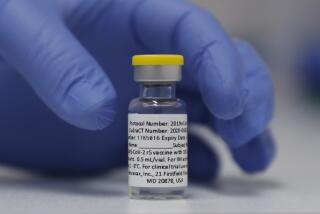Years of research bring hope with a melanoma vaccine
- Share via
No one can question Dr. Donald Morton’s tenacity. For 42 years, the medical director of the John Wayne Cancer Institute in Santa Monica has been working on a vaccine to prevent a relapse of malignant melanoma, the most deadly form of skin cancer.
He began developing his vaccine, Canvaxin, in the early 1960s. Then working at the National Cancer Institute, he saw a patient whose cancer “just went away,” even though it had spread to her liver and lungs. Such remissions, which tend to occur after the patient develops a bacterial infection, happen in about 1 in 2,000 to 5,000 patients with melanoma that has spread.
“We think the reason this happens is the immune system has been activated” by something like an unrelated infection, he said. “I said, if it happens spontaneously, maybe we can make it happen at will.”
Based on his most recent study, Morton says his vaccine may cure about one-third more people with melanoma that has spread, or metastasized, than existing therapies.
Advanced melanoma is usually treated with surgery to remove the tumor, followed by chemotherapy to kill cancer cells that may have escaped to distant parts of the body. But chemotherapy is toxic and, in such cases, often unsuccessful; the vaccine is intended as a replacement.
With the largest collection of melanoma cancer cell lines in the world, Morton was able to identify three lines rich with specific antigens, substances that produce a strong immune response. The cells were treated with radiation so that, although still alive, they could not divide and cause more cancer.
Because the vaccine has so many target antigens, it is considered a “generic” vaccine that could be given to any melanoma patient, regardless of the person’s particular type of tumor. Other researchers around the world also are working on “therapeutic melanoma vaccines,” Morton said.
Traditional vaccines prevent a disease by rallying the immune system to recognize an invader and attack it. The same concept, however, can be applied to prevent recurrence of a disease. The handful of melanoma vaccines in development operate on this premise, although they are in various stages of progress and differ in how they’re made. Some of them target an individual’s unique tissue type.
In a paper published last month, 49% of 935 patients who received the Canvaxin vaccine were alive after five years compared with 37% of 1,667 patients who received standard chemotherapy. Side effects include small sores on the skin (a reaction to the vaccine) that take about a month or two to heal and temporary flu-like symptoms.
Canvaxin, which is manufactured by CancerVax Corp. in Carlsbad, Calif., is administered five times in the first two months after surgery, monthly for 10 months and then sporadically for up to five years.
The success of the most recent study, published in the October issue of the Annals of Surgery, prompted the National Cancer Institute to issue a $29-million grant for a phase-three, randomized, controlled trial at 55 centers around the world. Results from this trial of 1,200 patients are expected in about three years.
“One of the Food and Drug Administration’s concerns is that, because of John Wayne Cancer Institute’s expertise in treating melanoma, our results won’t be duplicated at less specialized centers,” Morton said.
Morton said he’s confident the vaccine’s success can be replicated because of his experience -- not in spite of it. “In terms of tenacity, 42 years is probably a record.”
*
(BEGIN TEXT OF INFOBOX)
Facts about melanoma
Melanoma is the most serious form of skin cancer, affecting about 51,000 people in the United States each year.
Rates of the disease have increased about 3% a year since 1981.
Risk factors include exposure to ultraviolet light (including a single, severe sunburn); exposure to coal tar, arsenic compounds or radium; family history; and having multiple moles.
Rates are 10 times higher in whites than in blacks.
About 7,800 people die each year of melanoma.
Signs of melanoma include any change on the skin, especially in the size and color of a mole or a darkly pigmented spot.
Source: American Cancer Society






